 Written by Mike Price, OT
Written by Mike Price, OT
Hospital beds are used in a home care setting when additional support is needed for a person to enter and exit the bed, for recovering from certain medical conditions, or if a person will need to spend more time in the bed than is typical for a night of sleep. Hospital beds for home use minimize fall risk, facilitate easier transfers in and out of bed, adjust to suit patient comfort and postural needs, and reduce bed sores. Using a hospital bed at home can take strain off of caregiving by removing the need to constantly work around the limitations of a standard bed.
There are so many benefits to choosing home care over care facility or hospital care. Research has shown patients are much more comfortable with their surroundings at home, they are less likely to go to the emergency room, and the cost for care at home is significantly less than in a facility or hospital setting.
Creating the safest and most comfortable environment is your top priority, but with so many options and accessories to choose from when purchasing a hospital bed for home care, it can be overwhelming. Our comprehensive guide will point out what to consider, answer your questions, and recommend best-selling products.
The three types of home hospital beds to choose from are manual, semi-electric, and full-electric. They vary in price points and how they are adjusted for patient care and comfort. Read below for pros, cons, customer feedback, and product recommendations for each type of hospital bed!
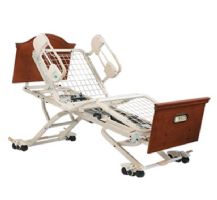 | UltraCare XT Four Section Joerns Hospital Bed Frame with Trendelenburg View Product |
Full electric beds allow for the height, head, and feet position adjustments to be made with a handheld remote control or buttons in the bed’s side or foot panel. This provides more independence for the user, who can make position adjustments without caregiver assistance. Most full-electric home hospital beds have a lock-out feature that prevents patients from accidentally adjusting the bed into a position that could be dangerous. Read more on Rehabmart's The 5 Best Full-Electric Hospital Beds!
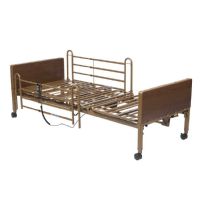 | Competitor II Semi-Electric Hospital Bed by Drive Medical View Product |
Using a combination of manual and electric adjustments, the head and foot sections of a semi-electric bed are usually adjusted electrically, while the bed height is adjusted with a manual crank. This style works well for patients who are steady enough on their feet that they don’t need the height of the bed adjusted to transfer on and off the bed. It allows the user the independence that comes from adjusting the head and foot sections for their own comfort.
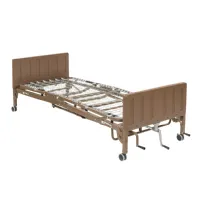 | Adjustable Manual Hospital Bed by Drive Medical View Product |
Manual home hospital beds are less expensive but they are the most basic models and have fewer features than semi-electric or full-electric models. Adjustments are made manually with a hand crank, which can put physical strain on a caregiver. Manual beds are best if frequent adjustments aren’t necessary.
Your loved one is unique, as is your home. When choosing a hospital bed for home use, there are many design features that contribute to a comfortable and individualized user experience, and make the process of providing care at home easier for everyone. Here are some specialty beds that might be better-suited for your unique needs.
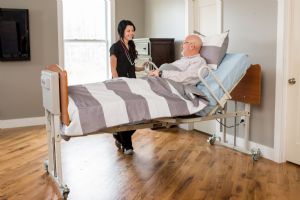 | Med-Mizer Comfort Wide EX8000 Power Adjustable Bariatric Bed View Product |
Bariatric patients often find themselves in places that are not built to accommodate them. A hospital bed shouldn’t be one of those places. A bariatric home hospital bed provides comfort and support to meet the physical needs of the patient, while being sized appropriately to ensure a patient’s dignity is maintained. Standard hospital beds accommodate patients weighing between 350 and 450 pounds. Bariatric hospital beds are specifically designed for patients weighing up to 1,000 pounds. Bariatric patients who need hospital bed functions like height adjustability or safety rails, and the additional sturdiness of heavy-duty construction and extra width, benefit from using one of these electric homecare hospital beds. Check out Rehabmart's Top 5 Best Bariatric Hospital Beds!
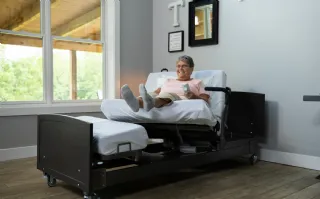 | ActiveCare Rotating Pivot Lift-Assist Bed by Med-Mizer View Product |
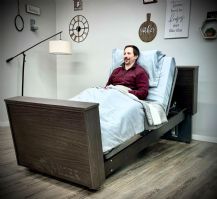 | SelectCare Elegant Styling Hospital Bed by Med-Mizer View Product |
Residential design beds have the functionality of hospital beds with the style of a bed you’d find in a bedroom at home. Height adjustability and the installation of side rails maximize the opportunities for user independence, making it easier to get in and out of bed than is possible with standard non-adjustable models. They defend against bedsores with pressure relieving properties, and ergonomic positioning allows for maximum comfort and support. Waterproof mattress covers help create a sanitary environment suitable for a clinical setting with the benefits of being in a comfortable home environment.
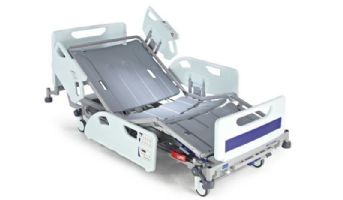 | Arjo Enterprise 9000X Hospital Bed View Product |
A deluxe bed is designed to meet the needs of acute-care patients and their caregivers. With a long list of features, deluxe beds are built for heavy-duty long-term use. Caregivers can be confident that patient safety is prioritized, with the side rails, minimized entrapment risk, and exit alarms of these beds. Patients have control over their own comfort with position adjustability, a nurse panel, and user-friendly controls. The ability to deliver care and treatment is enhanced by maneuverability, electric height adjustability, and the long list of convenient accessories that come with deluxe beds.
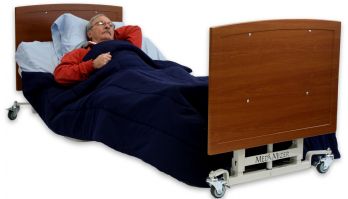 | AllCare Floor Bed by Med Mizer View Product |
Low beds reduce the distance from the bed to the floor, which lowers the risk of a fall and a potential injury. They take strain off a caregiver by making it easier for patients to get into and out of bed. Most low beds come with electric height adjustability and many provide positional adjustability to elevate and recline the head and feet sections and allow for ergonomic sitting and lying down. It’s also important to note that not all low beds have the same level of height adjustability, so pay attention to how low a bed goes. See more on Rehabmart's The 5 Best Low Beds for Fall Prevention!
.png&newwidth=365&maxheight=200) | Power Rotating HomeCare Bed: The Rotor Assist View Product |
All adjustable beds can be positioned for maximum user comfort and support for sleeping, reading, eating, watching tv, or just relaxing in bed. There are models that can take the user from lying flat to standing upright to facilitate walk-off transfers, some have high-low height adjustability to help prevent falls, and some look very similar to regular beds so they create a more homey feel for the patient. There are manual adjustable bed frames, but they are very basic models with not many position options, and they are not found in caregiving settings. Electric adjustable beds work well for people who need the repositioning available from a home hospital bed but who want more of the feel of a standard bed. Read more about Innovative Adjustable Hospital Beds by Med-Mizer and check out our Top 5 Adjustable Beds for Seniors!
If a patient can get in and out of bed without assistance and is steady while standing, a highly adjustable bed might not be needed. However, if a user can’t get repositioned independently and/or can’t safely get in and out of bed without the bed height being adjusted, a semi- or full-electric homecare hospital bed will be the best choice.
If a patient is spending the majority of the day in bed, bed sores can develop on bony areas of the body that are pressing against a mattress all day. Homecare hospital beds that adjust to take pressure off heels, shoulder blades, and the lower back, topped with mattresses that relieve pressure and encourage airflow, will help prevent and heal pressure ulcers for bedridden patients.
For someone who spends more than 15 hours a day in bed, or who will be cared for in bed for an extended period of time, a full-electric bed will provide long-term comfort and reduce long-term physical strain on caregivers. Manual and semi-electric beds require more caregiver effort and don’t provide as much independence for patients, but because they are less expensive they can be more appropriate for short-term use.
Users who are shorter or taller than average could benefit from shortened or extended bed frames. For larger framed or heavier patients, a bariatric bed would be more comfortable than a standard sized bed. Pediatric patients are safer and more comfortable in homecare hospital beds that are designed specifically for children.
Standard hospital beds provide basic positioning like raising or lowering the back or feet, but many health conditions benefit from additional options. For example, the Trendelenburg position (tilting the bed so the user’s feet are above the head) is used to treat surgical air embolisms, aid abdominal hernia reduction, and help with placement of vein catheters, plus it stimulates blood perfusion in patients with respiratory problems. Reverse Trendelenburg (tilting the bed so the user’s feet are sloping down) is useful when increased exposure is needed for attention to areas like the prostate and upper abdominal region, and it can be used to increase respiratory function in overweight patients by relieving pressure to the head. Another position is the cardiac chair position (placing the user semi-upright with legs straight or bent), which provides relief to lungs and aids in circulation during recovery from respiratory illness or cardiac surgery
When choosing a homecare hospital bed, caregiver needs should be taken into consideration so a proper level of care can be provided in a manner that is safe for everyone. A manual bed, especially if there are going to be a lot of position changes, can be physically taxing for a caregiver to adjust. An electric bed, although the more expensive option, will take the most strain off a caregiver. The physical challenges of caregiving can impact the care environment, so a caregiver’s stamina should be taken into consideration when deciding which home hospital bed is the best choice.
A: Medicare Part B covers hospital beds as durable medical equipment (DME) that is prescribed by a doctor for home use.
A: Many hospital beds assemble in the same manner and can be done in a matter of minutes. The foot-spring and head-spring sections latch together in the center, the spring links are connected, heat and footboards are then assembled and attached, then for electric beds the drive shaft for height adjustment and the motor are installed. Consumers also have the option of beds with assembly services.
A: When you are committed to caring for someone at home whose condition requires positioning of the body while in bed to alleviate pain, promote good body alignment, prevent contractures, and avoid respiratory infections in ways that can’t be accommodated by a standard bed, or when the user’s condition requires special attachments that need to be used with a hospital bed.
A: With so many styles and options, there is a wide range of prices for home hospital beds. When shopping for a homecare hospital bed, you can expect to find models costing between $500 and $10,000.
A: There are many styles, designs, and sizes to choose from. Questions to ask when determining what is the best hospital bed for use in your home include how many hours per day will the patient be in the bed, how long will the bed be needed, is the patient able to get out of bed, what is the size of the user, what functions are needed, and what is the budget for this purchase. For more information, check out Rehabmart's How to Choose a Hospital Bed for Home Care.
A: Typical hospital bed dimensions for the frame inside the headboard and footboard are about 80 inches long and 36 inches wide in standard models. Including the headboard and footboard, the area a bed takes up may increase to 84 inches long by 36 inches wide.
A: With semi-electric and full-electric hospital beds, the head and foot raises and lowers electrically. The bed is raised and lowered eleclectrically only in a full-electric bed, and has to be adjusted manually with a crank in a semi-electric model.
A: BMI is a good predictor of the space an individual requires to move from supine to side lying. In a standard size hospital bed, a patient with a BMI greater than 35 would not have enough space to be turned in either direction within the bed without lateral repositioning. A patient with a BMI greater than 45 could not be turned at all, even if repositioned to one edge of the surface before being turned. Patients.
Providing care at home for a loved one can be challenging on several fronts. Having the right equipment can make a big difference in the quality of care that can be provided, and in the quality of life enjoyed by the patient. Comfort and safety are key considerations when deciding How to Choose the Best Hospital Bed Mattress for Home, since many people receiving care at home spend a lot of time in bed. The 4 types of hospital mattresses are: innerspring, foam, air, and hybrid/combination. Below we explain the key differences between each mattress and recommend our best products.
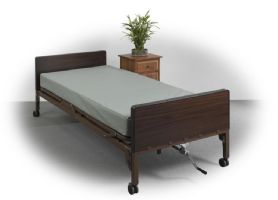 | Drive Medical Ortho-Coil Super Firm Support Innerspring Mattress View Product |
Innerspring mattresses are generally the most economical options for home hospital bed mattresses. This style of mattress is constructed with evenly distributed inter-mattress coils, and can be soft or firm, depending on the user’s personal preference. This style of mattress is best for users who aren’t bedridden and who have several hours of mobility each day.
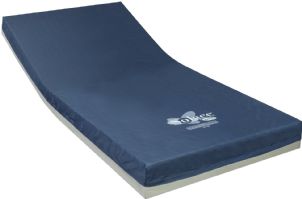 | Solace Prevention Therapeutic Foam Mattress by Invacare View Product |
Foam mattresses are lighter than their innerspring counterparts, and are about as economical. They absorb more shock than an innerspring mattress, but don’t breathe as well, so users can get hot and uncomfortable in bed. If bedsores are a concern, shop for one that is designed to shift and redistribute the user’s body weight so pressure ulcers don’t form.
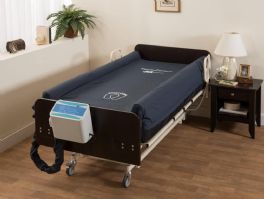 | Comfort Zone Cell-On-Cell LAL (Low Air Loss) Mattresses by Medacure View Product |
Low air loss mattresses reduce pressure on weight-bearing areas of the body, and are beneficial for low-mobility patients with bedsores. These mattresses reduce skin moisture, and many models are “zoned” for different pressure points where patients commonly develop pressure ulcers. Check out Rehabmart's Top 5 Low Air Loss Mattresses!
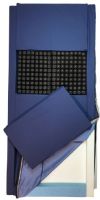 | Adapt 2 Modular Mattress with ROHO, GelFlex, and High Resiliency Foam View Product |
There are mattresses that combine some elements of innerspring, foam, air, and gel mattresses to create an environment that reduces the negative effects of pressure, shear, and friction on the skin. These mattresses go by the name 'combination mattress' or 'hybrid mattress'. Combinations of foam layers, air cells, spring coils, and gel inserts are arranged to promote airflow while distributing weight. This keeps the user cooler, drier, and less susceptible to pressure ulcers.
There are many features and benefits offered by innerspring, foam, low air loss, and alternating pressure mattresses. As noted earlier, each style addresses issues faced by users of home hospital beds. However, there are a few types of hospital bed mattresses that can address specific patient conditions.
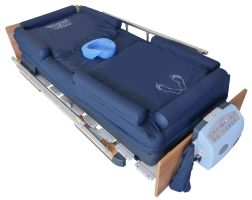 | Low Air Loss Mattress with Inflatable Guardrail and Bed Pan Access | OB-2680 PremiumAir View Product |
Low air loss mattresses can help prevent and treat pressure wounds. They are great for any patient who can’t shift or reposition independently while lying in bed, which makes them susceptible to skin issues. These mattresses are also good for users who have medical conditions affecting blood flow. Alternating pressure mattresses are a kind of low air loss mattress that inflates and deflates air cells to gently shift a user’s weight. This relieves constant pressure on vulnerable bed sores. They mechanically distribute weight over a large contact area and vary the pressure beneath the user to reduce the intensity and the duration of pressure. A great option is a mattress that offers continuous low air loss and alternating pressure plus lateral rotation.
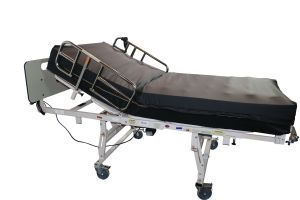 | Low Air Loss Mattress for Wound Healing and Reduced Pressure | Made in the USA! View Product |
Pressure-relieving mattresses either distribute a patient’s weight over a larger contact area to reduce the intensity of pressure, or mechanically distribute weight over a large contact area and vary the pressure under the patient to lessen the intensity and duration of pressure.
The sole purpose of a pressure-relieving mattress is to prevent and/or help heal bedsores. There are several options and materials available that are used to address skin issues. Foam, including gel-infused foam, can be layered or combined with air cells to create mattresses or overlays that will protect patients from developing pressure sores. Read more on Rehabmart's How to Choose the Best Pressure Relief Mattress and The 5 Best Pressure Relief Mattresses.
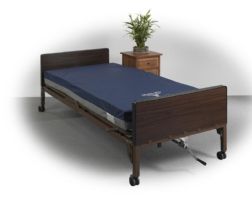 | Drive Medical Multi-Ply ShearCare 1500 Pressure Reducing Mattress View Product |
Heavy-duty bariatric mattresses are made for use with hospital beds that have positioning functions that raise and lower the head and feet. They can accommodate users weighing up to 1,000 pounds, so weight capacities should be noted. Because they are made with materials that make them significantly stronger than standard hospital bed mattresses, they are usually more expensive to purchase.
A: Compared to foam or gel surfaces that apply constant pressure to the skin, beds, mattresses and mattress toppers that regularly redistribute pressure under the body may reduce the chance of pressure ulcers developing.
A: The standard hospital bed mattress is 36 inches wide by 80 inches long.
A: No, hospital beds have their own specific mattresses that are not only sized for hospital bed frames, but are also able to accommodate raising and lowering the head and feet sections of the bed. Check out our 5 Best Hospital Bed Mattresses for our top sellers!
A: Memory foam comfort layers, whether in all-foam or hybrid beds, are more prone to trap body heat. High rebound mattress toppers facilitate a drop in core body temperature, which enhances deep sleep. Sleeping cooler is a benefit for anyone at risk of skin issues that can arise when the skin is not kept dry, including people who can’t reposition themselves easily to release trapped heat.
A: A bariatric hospital mattress is made larger to accommodate bariatric bed frames that are created for patients who weigh up to 1,000 pounds. It has a heavy-duty design and is manufactured to be extra supportive to accommodate larger patients.
There are lots of accessories available for homecare hospital beds that can enhance safety, functionality, and convenience for users. Hospital bed accessories are not required, but they can prove to be priceless in certain situations.
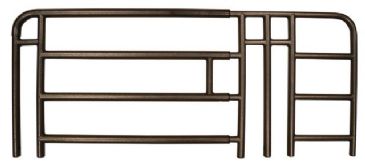 | Universal Full-Length, Spring-loaded Telescoping Side Rails View Product |
Bed rails come in full- or half-lengths and can go on one or both sides of the bed. They help prevent bed falls, give a user a handhold for repositioning in bed, and provide something to hold on to for balance when getting in and out of bed. Check out How to Choose a Bed Rail for a comprehensive guide for choosing the best bed rail for your situation. Also, see 5 Best Side Rails for Homecare Hospital Beds for Rehabmart's favorite bed rails!
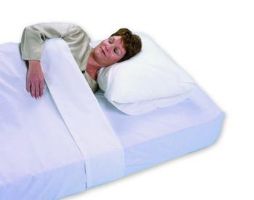 | Hermell Products Hospital Bed Sheet Set View Product |
Hospital linens are sized for hospital beds, and many of them feature anti-friction panels or anti-shear material to help prevent bedsores. Anti-friction material can also make it easier to reposition a patient without having to pull at delicate skin. In addition to sheets, other options for hospital-size beds include waterproof mattress and pillow covers, anti-allergen bedding, and disposable linens that help prevent the spread of germs. Read more on Rehabmart's How to Choose Hospital Bed Sheets and Bedding!
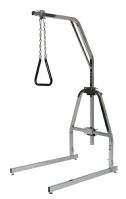 | Lumex Free-Standing Bariatric Trapeze View Product |
For someone living with limited mobility who is confined to bed for long stretches, a hospital bed trapeze helps with independent repositioning for comfort and pressure reduction. Some models also provide support to make transfers in and out of bed safer. A trapeze can be life changing for someone who is bedridden, providing a way to be more independent and mobile. Read more on Rehabmart’s 5 Best Hospital Bed Trapezes article!
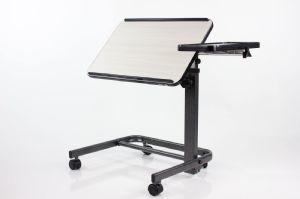 | Acrobat Adjustable Overbed Table with Wheels by Platinum Health View Product |
An overbed table provides a solid surface for activities like eating, reading, and working on a laptop for anyone who spends a lot of time in bed. These tables are affordable and convenient for home use, sliding over the bed for more accessible than a side table or tv tray. Read more on Rehabmart’s 5 Best Overbed Tables article!
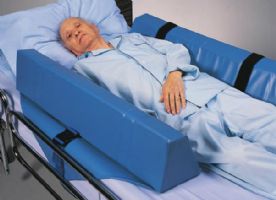 | Skil-Care Roll Control Bolsters View Product |
There are seven entrapment zones on a hospital bed, and hospital bed rails do pose the potential of entrapment if a patient gets entangled with a side rail. Users who are cognitively impaired, can’t communicate, have dementia, suffer from seizures, have neurological disorders and uncontrolled perpetual movement. If rails aren’t specifically designed to reduce the risk of entrapment, pads or protectors should be added to eliminate the risk of a patient getting stuck in bedside rails. The FDA recommends ensuring that each component of a home hospital bed fits together properly, confirming the mattress is correctly sized for the bed frame to eliminate gaps, use rails cautiously, and determine if a component or accessory is compatible with the bed frame to provide gap protection. View all Gap Protection products.
Caring for a loved one at home can be overwhelming. Choosing the right equipment to provide that care shouldn’t be. We’ve compiled this guide to help you navigate through the options available and the features to consider when it’s time to choose a homecare hospital bed. By answering your questions and explaining the kinds of beds, mattresses, and accessories that are available, we’ve equipped you to make informed purchasing decisions for this important piece of medical equipment.
Check out more educational resources on Caregiver University, where you can find a wealth of information about how to provide the best home care possible for your loved one. For more products, view our entire selection of Hospital & Home Care Beds.

Co-Founder of Rehabmart and an Occupational Therapist since 1993. Mike has spent his professional career working in multiple areas of Occupational Therapy, including pediatrics, geriatrics, hand therapy, ergonomics and inpatient / outpatient rehabilitation. Mike enjoys writing articles that help people solve complex therapeutic problems and make better product choices.